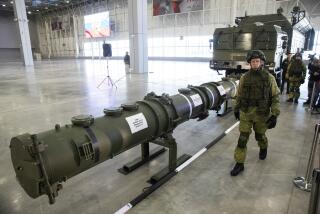U.S. Will Scrap 2 Subs, Honor SALT : Reagan to Abide by Unratified Pact Despite Cheating Charges, Aides Say
- Share via
WASHINGTON — Despite repeated charges of Soviet cheating, President Reagan has decided to go the “extra mile” once again to comply with the unratified SALT II treaty by dismantling two older Poseidon missile submarines next month, Administration officials told The Times on Monday.
However, the President also has called for several steps to compensate for the alleged Soviet treaty violations. These include doubling the number of MX intercontinental ballistic missiles to 100 from 50; accelerating work on the small Midgetman ICBM and on the advanced (stealth technology) cruise missile, and studying whether to put three warheads on Minuteman 2 ICBMs that now have one warhead.
Some of these steps could also violate the strategic arms limitation treaty if implemented without first eliminating other weapons to remain under the ceilings set by the agreement. But none of them would immediately breach the agreement, officials said.
His Last Good Chance
In the action, Reagan also appears to have foregone his last good chance to cancel an agreement that he has called “fatally flawed,” although he has agreed “not to undercut” its provisions if the Soviets did the same.
He could at any time decide to go over the SALT limits; the next submarine does not face premature retirement until 1988. But breaking the agreement during his last year in office, amid an election campaign, is considered unlikely.
As a result, many arms control advocates believe that the compliance issue has survived the Reagan Administration. These arms control supporters also believe that Reagan’s move now should improve the climate for the resumed U.S.-Soviet negotiations in Geneva next month and for a new summit meeting.
Two senior U.S. arms control advisers are now being sent to consult with U.S. friends and allies abroad--Ambassadors Paul H. Nitze in Europe and Edward L. Rowny in Japan and China, on whether to remain in compliance with SALT II, White House spokesman Larry Speakes said Monday.
Reagan has made up his mind to comply with the treaty, Administration officials said. But Speakes, for public consumption, described the President’s position as “tentative thinking” and insisted that “no final decision has yet been taken--and will not be until the consultations are complete. We will not comment on the substance of the consultations at this time.”
Backed by NATO, Japan
Administration officials said that since the North Atlantic Treaty Organization nations and Japan are known to strongly favor the position Reagan has reached their endorsement is a foregone conclusion. After that, the President’s National Security Decision Directive to comply with the treaty signed Monday will become final.
The decision was forced upon the President by the Navy’s plans to send the latest Trident submarine, the Nevada, with its 24 multiple-warhead missiles, to sea for trials next month. Under SALT II, signed in 1979 but never ratified by the U.S. Senate, both nations can have a maximum of 1,200 such multi-warhead weapons.
Because the United States now has 1,198 multi-warhead missiles and bombers, it would have to retire at least 22 missiles to stay under the ceiling.
The best solution to remain in compliance with the agreement was to dismantle two Poseidon submarines, each with 16 missiles. The alternative was to keep them in use, thus breaching the agreement’s limits.
The decision was particularly difficult because Reagan, when faced with a similar decision last June, agreed to dismantle a submarine but set three stiff conditions for continued compliance: a slackening of the Soviet military buildup, progress in the arms control talks and an end to Soviet cheating on arms agreements.
At most, only one of these criteria has been satisfied, in that the arms control issue was arguably advanced at the summit meeting with Soviet leader Mikhail S. Gorbachev last November.
Favored Shultz View
In his decision, Reagan basically chose the path favored by Secretary of State George P. Shultz rather than that recommended by Defense Secretary Caspar W. Weinberger, who wanted the United States to get out of the agreement because of Soviet cheating.
The Administration has accused the Soviets of 18 violations of various arms agreements, including seven of SALT II, such as encoding the telemetry information radioed from missile test flights and building two new ICBMs when only one is permitted.
The Joint Chiefs of Staff made no recommendation on whether the agreement should be abrogated, arguing that it was essentially a political, rather than military, issue. The joint chiefs also said that full funding of the Administration’s weapon modernization program was sufficient response to the Soviet cheating.
But Adm. William J. Crowe Jr., chairman of the joint chiefs, indicated his opposition to continued compliance with the restrictions of the treaty, offering his “personal and professional” opinion during a hearing of the House Appropriations subcommittee on defense.
“I find it very difficult to believe the United States should continue to abide by that (treaty) when the other partner in the contract has not,” he said. But he declined to disclose the advice the joint chiefs had given to Reagan.
Controversial MX Missile
Of four programs to be intensified, the request for 50 more MX intercontinental ballistic missiles is likely to create the greatest controversy. Congress has authorized only 50 so far.
The Carter Administration, when it conceived the huge ICBM 10 years ago, wanted a force of 200 MXs, each to be hidden among multiple shelters. Dozens of such “deceptive basing modes” were proposed. Reagan rejected them all, but his alternative was to put the MX into Minuteman silos.
Congress objected, largely because the 10-warhead MXs would be a vulnerable target in those silos. In a compromise, the Administration agreed to begin work on the Midgetman mobile ICBM and to cut its request to 100 MXs. But Congress subsequently reduced the number of MXs to 50.
Whether it will now increase the number, in an atmosphere of fiscal restraint, is uncertain, although many of the strongest opponents of MX are also the strongest supporters of SALT II and arms control.
They also are among the supporters of the Midgetman, work on which Reagan now proposes to accelerate. The Midgetman, a single-warhead ICBM, is a favorite of arms control champions because of its mobility. It has been criticized as too costly per warhead, however, and at the Geneva talks on arms control, the Administration has even proposed banning all mobile missiles.
The third step would accelerate development of the advanced cruise missile, a winged drone with “stealth” features--composite plastic and curved surfaces that make it almost invisible to radar.
The final step will be to study whether to put three warheads atop the existing single-warhead Minuteman 2 ICBMs. The United States now has 450 Minuteman 2s, as well as 550 Minuteman 3s, which carry triple warheads.
More to Read
Sign up for Essential California
The most important California stories and recommendations in your inbox every morning.
You may occasionally receive promotional content from the Los Angeles Times.










